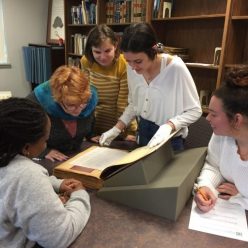By Lara Canner, Curator of Music Special Collections
As Taylor Swift once sang “I think he did it but I just can’t prove it…”, true crime and music go hand in hand. There are hundreds of ballads based off horrific crimes: Nirvana’s “Polly”, the Smiths “Suffer Little Children” and Sarah McLachlan’s “Possession”, to name a few. Music invites passion, heartbreak, darkness, and yearning. It is no wonder that musicians have found a font of inspiration from terrible crimes and their instigators. Yet, not only has music immortalized tales of the horrific, but musicians are also the victims of true crime stories and the initiators.
True crime storytelling is having a cultural moment, but where do you think the researchers for the multitude of podcasts, books, and documentaries have gotten their information? Enter archives: the keepers of knowledge. Special Collections and archives are responsible for preserving and making accessible historic record, ranging from newspapers, court documents, organizational records, oral histories, and even films from television stations. Without an archive there would not be documentation for amateur investigators to pour over, map and theorize. There are so many in fact that archivists from the University of North Texas created an entire series called “True Crime in the Archives.”
If you are searching for your music true crime fix (featuring archives!), here is a list of podcasts, books, and documentaries to checkout.
Podcasts:
- Songs in the Key of Death – https://nevermind.fm/shows/death//
- Disgraceland – https://www.disgracelandpod.com/
Books:
- Ladies and Gentlemen, the Bronx is Burning by Jonathan Mahler
- BMF: The Rise and Fall of Big Meech and the Black Mafia Family by Mara Shalhoup
- Lords of Chaos: The Bloody Rise of the Satanic Metal Underground by Michael Moynihan and Didrik Søderlind
- Hit Men: Power Brokers and Fast Money Inside the Music Business by Fredric Dannen
- Notorious C.O.P.: The Inside Story of the Tupac, Biggie, and Jam Master Jay Investigations from NYPD’s First ‘Hip-Hop Cop’ by Derrick Parker and Matt Diehl
- CrimeSong: True Crime Stories From Southern Murder Ballads by Richard H. Underwood
- Unprepared To Die: America’s Greatest Murder Ballads And The True Crime Stories That Inspired Them by Paul Slade
- Party Monster: A Fabulous But True Tale of Murder in Clubland by James St. James
- Helter Skelter: The True Story of the Manson Murders by Vincent Bugliosi and Curt Gentry
- The Axeman of New Orleans: The True Story by Miriam C. Davis
Documentaries:
- The New York Times Presents: Framing Britney Spears on Hulu
- FYRE: The Greatest Party That Never Happened on Netflix
- I Called Him Morgan on Netflix
- Surviving R. Kelly on Netflix
- ReMastered: The Two Killings of Sam Cooke on Netflix
Music can inspire intense feelings causing us to cry, sigh, and dance for joy. Intense feelings can inspire music creating songs of sadness, love, and hope. Archives that specialize in music are filled with songs of terrible heartache and stories yet unsung. Even Old Dominion University Special Collections holds secrets too if you are willing to look.


